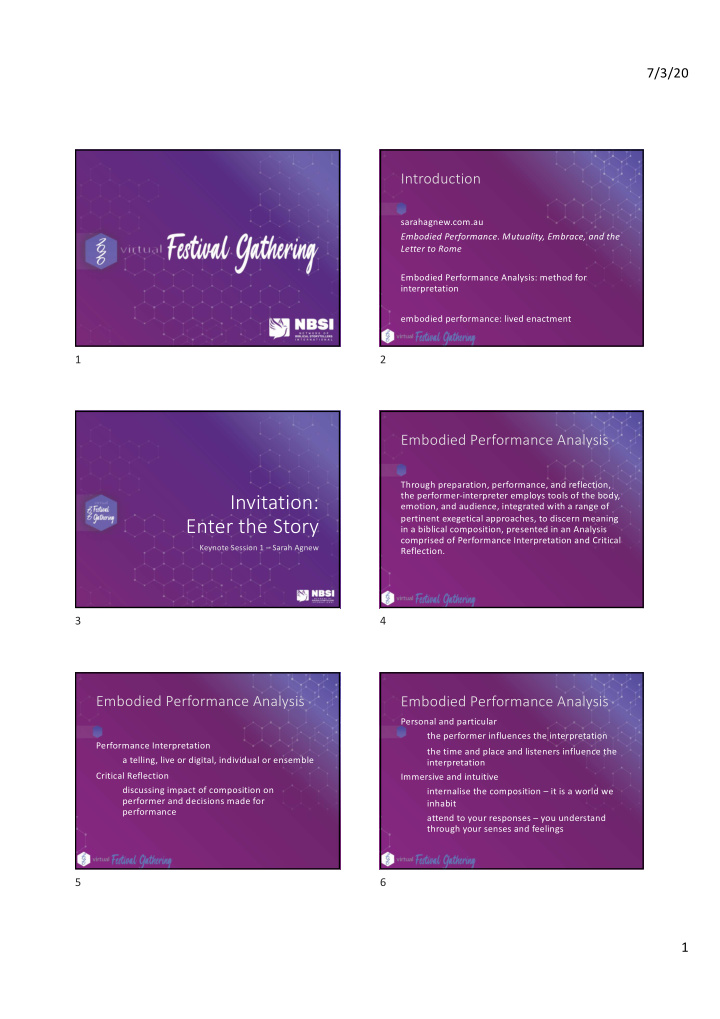



7/3/20 Introduction sarahagnew.com.au Embodied Performance. Mutuality, Embrace, and the Letter to Rome Embodied Performance Analysis: method for interpretation embodied performance: lived enactment 1 2 Embodied Performance Analysis Through preparation, performance, and reflection, Invitation: the performer-interpreter employs tools of the body, emotion, and audience, integrated with a range of Enter the Story pertinent exegetical approaches, to discern meaning in a biblical composition, presented in an Analysis comprised of Performance Interpretation and Critical Keynote Session 1 – Sarah Agnew Reflection. 3 4 Embodied Performance Analysis Embodied Performance Analysis Personal and particular the performer influences the interpretation Performance Interpretation the time and place and listeners influence the a telling, live or digital, individual or ensemble interpretation Critical Reflection Immersive and intuitive discussing impact of composition on internalise the composition – it is a world we performer and decisions made for inhabit performance attend to your responses – you understand through your senses and feelings 5 6 1
7/3/20 Method Tools Body how the body moves in response to the composition Step One: Preparation Emotion translation / adaptation, layout of ‘script’, how the performer-interpreter feels in rehearsal, preliminary performances response to the composition Step Two: Performance Audience one or more performances or tellings how the performer-interpreter listens to the audience, envisaging their audience in preparation Step Three: Reflection and anticipating as best they can how the ‘behind the scenes’ options and decisions audience might meaningfully receive this composition today 7 8 The body One’s ‘body is the fabric into which all objects are woven, and it is, at least in relation to the perceived world, the general instrument of [one’s] “comprehension”.’ Maurice Merleau-Ponty 9 10 The body – our task to interrogate our intuitive movements, and ask: • is this saying something about the composition or • is this saying something about me? ἀσπάσασθε • what do I keep from this movement, which will speak helpfully in mediation and interpretation of aspasasthe this composition for this audience today? 11 12 2
7/3/20 How much can we say between Emotion the words? An important question for interpretation and the form of interpretation is: Will I include comment Emotion, affect, feelings, passions, humours, moods? • within the performance, breaking out with asides • alongside it as sermon or lecture or conversation affective feelings • or not at all? If the latter: how much can my gesture, tone, expression, emotion, say between the lines of problematic portions? 13 14 Emotion Audience By identifying and examining our feelings, we From theatre studies we learn that the audience, with their presence, attention, responses and energy, • allow emotion to show us meaning as well as their discovering and making meaning for • allow our own story its space as it butts up against themselves, are co-creators in the performance the Bible – and find meaning there moment as much as performers, directors and the • allow us time to process our own story and to get creative and technical teams. out of the way Helen Freshwater 15 16 Audience as interpretive tool • in the imagination of the performer-interpreter while preparing the text • in the performance moment 17 18 3
7/3/20 Embodied Performance Analysis: Micah 6:1–8 19 20 Micah 6:1–8 – Audience Micah 6:1–8 – Audience Word plays and aural links • Consistent translation of rib – ‘case’ (NRSV case, Divine names then controversy) • Translate ‘B REATH OF L IFE ’ for YHWH (Adonai / T HE when the original language uses the same word / word group, do so in translation where possible to L ORD ) retain aural links for listeners • ‘They’ and ‘Their’ – non-gendered, plural pronoun • La ah – ah la – in translation, seeking wordplays • Translate ‘Holy One’ for El (God) with contrast up/down, and rhyme ‘worn’ / ‘brought’ • ‘Just acts’ – link expectation with Divine nature 21 22 Micah 6:1–8 – Audience Micah 6:1–8 – Body Cultural capital • Gesture suggests bringing gifts to placate the Divine • Moses, Aaron and Miriam – their equality is • Posture and voice indicate change of speaker important • Repeat of ‘remember’ – the important thing is to remember, when audiences today may not know the story they are urged to remember 23 24 4
7/3/20 Micah 6:1–8 Micah 6:1–8 – Emotion Personal and particular • Desperation in scene two • Translation: ‘house of slaves’ NRSV ‘house of slavery’ • Pause – hold the emotion Breath of Life restores identity: from slaves to ‘my • Emotional shift through the pause / silence – people’ desperation to calm reminder • ‘Only’ – pace and pause for impact 25 26 Prayer: ‘What is good’ Micah 6:1–8 27 5
Recommend
More recommend